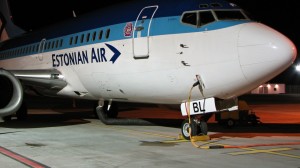
airBaltic's 2009 expansion appears to be succesful at Tallinn's main airport, at the expense of Estonian Air.
TALLINN — The latest statistics from Lennart Meri Tallinn Airport shows that the number of Estonian Air’s costumers is decreasing while the number of airBaltic’s costumers is slightly increasing.
Estonian Air served 45.8 percent of all Tallinn Airport passengers in 2005, but the number decreased to 41.4 percent in 2009. Meanwhile airBaltic’s customers doubled in one year, with their 6.6 percent share of passengers in 2008 increasing to [private_supervisor]13.1 percent in 2009.
Erik Sakkov, the director of marketing and sales in Tallinn Airport told the newspaper Postimees that the number of airBaltic’s custumers has grown largely thanks to the carrier’s strategy to turn Riga Airport into a connection station, increasing the number of flights between Tallinn and Riga significantly.
“Riga emerged to an important airport for connecting flights and is rivaling with other European connecting airports such as Helsinki, Copenhagen, Frankfurt and others,” said Sakkov.
Ilona Eskelinen, a press spokeswoman of Estonian Air said that the company is preparing for new challenges and is not afraid of airBaltic’s invasion.
“In addition to the latest on-board conceptions such as offering snacks and drinks in economy class, we are also planning other improvements and updates which we are not yet revealing,” Eskelinen told Baltic Reports.
Estonian Air has been focusing on development of regular destinations in recent years, and less on charter flights.
“So we have pulled back in charter market intentionally, which shows on our total market share, but at the same time the trend in regular market share is positive and moving up,” Eskelinen said.
Estonian Air cooperates with airlines SAS, KLM, Rossiya, Aeroflot and others to provide international flights throughout Europe. [/private_supervisor] [private_subscription 1 month]13.1 percent in 2009.
Erik Sakkov, the director of marketing and sales in Tallinn Airport told the newspaper Postimees that the number of airBaltic’s custumers has grown largely thanks to the carrier’s strategy to turn Riga Airport into a connection station, increasing the number of flights between Tallinn and Riga significantly.
“Riga emerged to an important airport for connecting flights and is rivaling with other European connecting airports such as Helsinki, Copenhagen, Frankfurt and others,” said Sakkov.
Ilona Eskelinen, a press spokeswoman of Estonian Air said that the company is preparing for new challenges and is not afraid of airBaltic’s invasion.
“In addition to the latest on-board conceptions such as offering snacks and drinks in economy class, we are also planning other improvements and updates which we are not yet revealing,” Eskelinen told Baltic Reports.
Estonian Air has been focusing on development of regular destinations in recent years, and less on charter flights.
“So we have pulled back in charter market intentionally, which shows on our total market share, but at the same time the trend in regular market share is positive and moving up,” Eskelinen said.
Estonian Air cooperates with airlines SAS, KLM, Rossiya, Aeroflot and others to provide international flights throughout Europe. [/private_subscription 1 month] [private_subscription 4 months]13.1 percent in 2009.
Erik Sakkov, the director of marketing and sales in Tallinn Airport told the newspaper Postimees that the number of airBaltic’s custumers has grown largely thanks to the carrier’s strategy to turn Riga Airport into a connection station, increasing the number of flights between Tallinn and Riga significantly.
“Riga emerged to an important airport for connecting flights and is rivaling with other European connecting airports such as Helsinki, Copenhagen, Frankfurt and others,” said Sakkov.
Ilona Eskelinen, a press spokeswoman of Estonian Air said that the company is preparing for new challenges and is not afraid of airBaltic’s invasion.
“In addition to the latest on-board conceptions such as offering snacks and drinks in economy class, we are also planning other improvements and updates which we are not yet revealing,” Eskelinen told Baltic Reports.
Estonian Air has been focusing on development of regular destinations in recent years, and less on charter flights.
“So we have pulled back in charter market intentionally, which shows on our total market share, but at the same time the trend in regular market share is positive and moving up,” Eskelinen said.
Estonian Air cooperates with airlines SAS, KLM, Rossiya, Aeroflot and others to provide international flights throughout Europe. [/private_subscription 4 months] [private_subscription 1 year]13.1 percent in 2009.
Erik Sakkov, the director of marketing and sales in Tallinn Airport told the newspaper Postimees that the number of airBaltic’s custumers has grown largely thanks to the carrier’s strategy to turn Riga Airport into a connection station, increasing the number of flights between Tallinn and Riga significantly.
“Riga emerged to an important airport for connecting flights and is rivaling with other European connecting airports such as Helsinki, Copenhagen, Frankfurt and others,” said Sakkov.
Ilona Eskelinen, a press spokeswoman of Estonian Air said that the company is preparing for new challenges and is not afraid of airBaltic’s invasion.
“In addition to the latest on-board conceptions such as offering snacks and drinks in economy class, we are also planning other improvements and updates which we are not yet revealing,” Eskelinen told Baltic Reports.
Estonian Air has been focusing on development of regular destinations in recent years, and less on charter flights.
“So we have pulled back in charter market intentionally, which shows on our total market share, but at the same time the trend in regular market share is positive and moving up,” Eskelinen said.
Estonian Air cooperates with airlines SAS, KLM, Rossiya, Aeroflot and others to provide international flights throughout Europe. [/private_subscription 1 year]
— This is a paid article. To subscribe or extend your subscription, click here.












